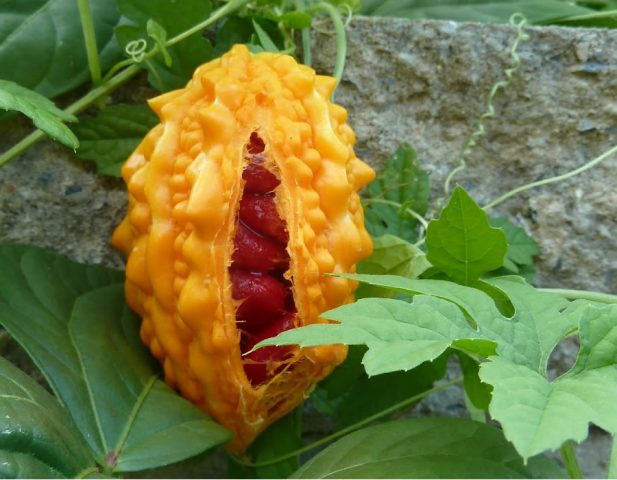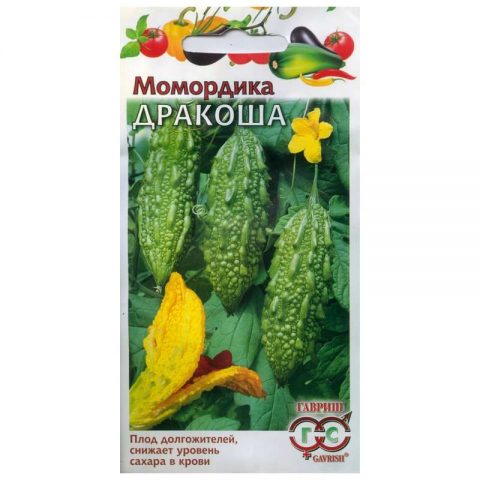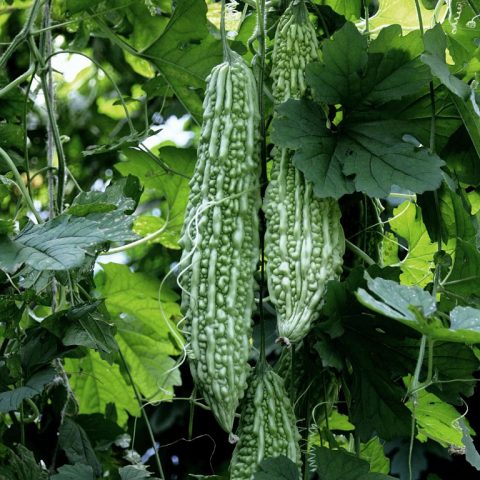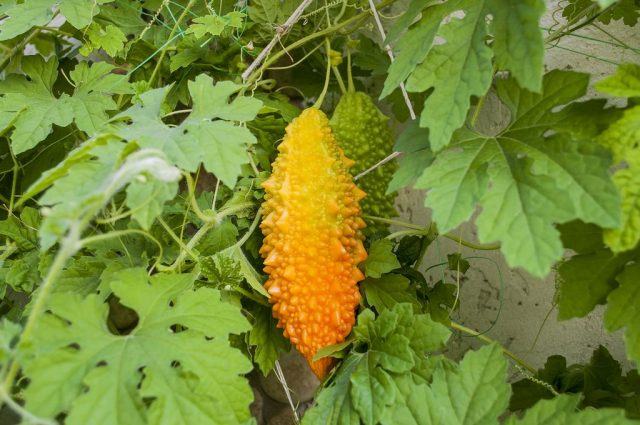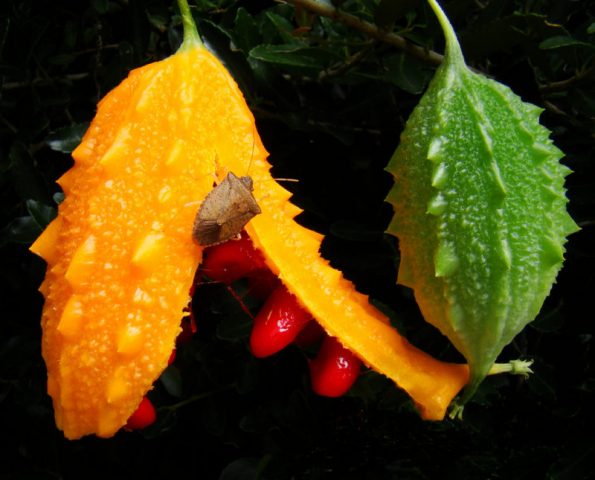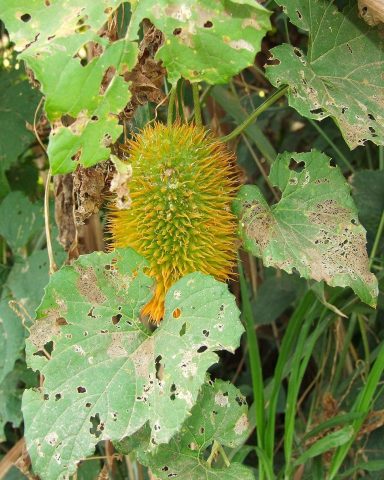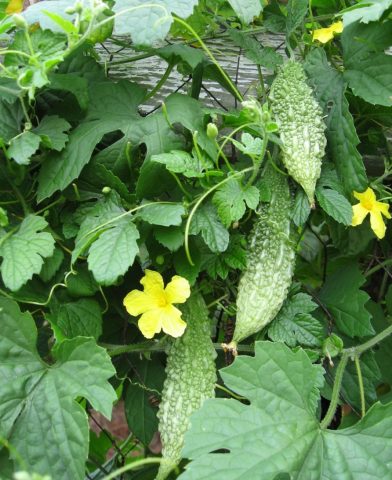Content
Momordica, whose photo impresses even experienced gardeners, successfully migrated from a tropical climate to a temperate one. The plant is adapted for growing in personal plots as a fruit or ornamental crop. Thanks to the interesting shape of the bright fruits, it does not go unnoticed.
What a Momordica plant
Momordica is a plant belonging to the Pumpkin family. There are more than 20 species in the genus that live in the tropics and subtropics of Southeast Asia. In Russia, the plant appeared relatively recently and immediately became popular with summer residents. In gardening, you can mainly find two types - momordica harantia and momordica cochinchin. The first species is grown more often, both as a fruit and as an ornamental crop.
Momordica has many names - Indian pomegranate, Indian cucumber, Chinese pumpkin, crocodile cucumber, bitter melon. It is an annual liana, reaching a height of 6-7 m. The leaves are beautifully carved, about 12 cm wide. Flowering begins in June, the plant throws out medium-sized light yellow buds, male and female, on the same bush. That is, one momordika is enough to set fruits. Flowers have a normal look, but fruits add decorativeness to the culture.
Young plants have hairs that cause irritation on contact with the skin. This explains the name of the vine - momordica in Latin means "biting". You can grow the culture as a houseplant - leaves, flowers and fruits look unusual and interesting.
What kind of momordica plant can be seen in the photo:
Description of Momordica fruits
Elongated fruits are covered with tubercles and growths. They are 7 cm wide and range from 7 to 35 cm in length, depending on the variety. At first, the fruit is green, but then it acquires a bright orange color, the seedlings are red. Momordica is also considered a medicinal plant due to its many vitamins and minerals.
The fruits are set immediately after pollination. When ripe, the fruits burst and become like large flowers with seeds similar to pomegranate seeds. The pulp itself is juicy, has a pleasant taste with a slight bitterness.
Types and varieties of momordica
Momordica has several types and varieties, each gardener can choose his own, based on his needs. This vine is often grown as a decorative one. The size of the fruit differs from one cultivar to another.
Momordika Drakosha
The plant loves warmth and open light areas, but it should be protected from the wind and the scorching sun. The soil should be light and fertile. Liana grows up to 2-2.5 m. The fruit of Momordica is similar to a cucumber with tubercles, its length is about 23 cm, and its color when ripe is yellow-orange. Average weight 170 g. Inside the pericarp of a ruby hue, reminiscent of persimmon in taste. The shell pulp itself is similar to a pumpkin.
Momordika Gosh
The Momordiki variety Gosha was bred for cultivation in Siberia, entered into the State Register in 2006. The fruits are light green, their size reaches 35 cm, and the weight is about 400 g. The yield is high.The bumps on the surface are pronounced, the taste is characterized as spicy with hints of bitterness. The plant loves light and when planted in shaded areas there is a risk that the growing season will be delayed. Momordica in Siberia is grown in greenhouses under a film, in the open field it does not survive. The Gosha variety is practically not susceptible to disease, resistant to aphids and spider mites, but can be damaged by the greenhouse whitefly.
Momordika Jadet
This variety is distinguished by its decorative appearance. Momordika Jadet has bright yellow fragrant flowers with long legs. The fruits are covered with a skin that is slightly bitter, but inside they are sweet and pleasant in taste. They are yellow-orange in color, reach a size of 20 cm, have a pointed tip. The height of the vine is about 2 m, and the average weight of the fruit is 100 g. In order to obtain a harvest, momordica is planted in greenhouses, and if only its decorative qualities are needed, then they are placed along fences or in gazebos.
Momordika Naya
Vines have long and thin stems, they are placed on a trellis and pinched during growth. The culture does not tolerate frost at all, therefore it is planted in the ground when the warm weather finally settles. The fruits of the Naya Momordica are elongated and oval in shape, in a mature state they have a size in the range of 15-25 cm. The crop is harvested after 8-10 days from the formation of ovaries. The fruits are bitter, so they are soaked in cold water before eating.
Momordica balsamic
Liana grows up to 5 m and has a large green mass of leaves. Fruits are warty, bright orange in color. The crop is harvested on the 10th day, and to remove the bitterness, momordica is soaked in salt water. When fully ripe, the fruit bursts with a bang, releasing the seeds. This variety has the best healing properties of all. However, his fruits are relatively small, fusiform.
Momordica smelly
It is a perennial plant, reaching 7 m in length. A not very pleasant smell emanates from it, which is why this name is due. The leaves are carved in a triangular shape, pubescent, their size reaches 20 cm. The flowers are dioecious up to 4 cm in diameter, the males are collected in inflorescences of 8 pieces, and the females remain solitary. Their color can range from yellow to orange. The fruit is in the shape of an ellipse, resembles a pumpkin in color and is covered with thin thorns. Its size does not exceed 10 cm.In tropical climates, it is often found in the fields as weed... This vine does not have pronounced decorative qualities and is not used for food, but retains its medicinal characteristics.
Momordica Jade
An annual plant, which is a highly branched liana. It takes about 70 days from planting to fruiting. When mature, Momordica Jade is orange-yellow, rather large, about 30 cm long. Fruit weight reaches 300 g. The surface is covered with deep bumps. Unripe fruits taste a little bitter, but the main taste of their pulp is pleasant and allows them to be consumed fresh. The plant has high decorative qualities.
Planting and caring for momordica
Momordica is an annual plant, therefore it is propagated by seeds. Moreover, both seedling and non-seedling methods are used. The first option is used more often, especially in regions with a cold climate.
Growing Momordica from seeds at home
Before growing momordica from seeds, you must first prepare them:
- The light ones remove, because only the dark ones are mature.
- The seeds must be dipped in a glass with a weak solution of potassium permanganate.
- A piece of cloth is soaked in 200 ml of warm water with a teaspoon of honey.
- Seeds are placed in this napkin after disinfection and removed to a warm place.
- The fabric is moisturized as it dries.
Seedlings will appear after a couple of weeks. Sprouted seeds are planted in peat cups.
A mixture of earth and humus is placed in cups in a 1: 3 ratio. The soil is calcined for 2 hours for disinfection.In this way, insect larvae and fungal spores are destroyed.
Landing is carried out as follows:
- the seeds are buried with an edge into the ground by 2 cm;
- then they are sprinkled with sand and carefully watered;
- the top is covered with polyethylene, but so that there is air access and the required humidity remains.
The room temperature must be maintained at least + 20 ° С. It is worth waiting for the emergence of seedlings no earlier than 2 weeks later. When the sprouts appear, the film is removed and the soil is sprayed from the sprayer. Momordica seedlings should be protected from direct sunlight.
When the first true leaves appear, the plant is fed with potassium sulfate and superphosphate. It is not recommended to use nitrogen fertilizers. The room temperature is reduced to + 18 ° C. It is required to provide seedlings with protection from drafts and a sufficient amount of light. Two weeks later, organic fertilizing is introduced, and after another two mineral compositions. The soil should not be allowed to dry in cups, but at the same time, watering should be moderate. Seedlings must be hardened by exposing them, for example, to the balcony.
Transfer to open or protected ground
When the plants reach a height of 25 cm, they are transplanted into a greenhouse or open ground. In the case of indoor growing, simply move to a larger pot. Momordica is transferred to a permanent place right in the cups, because the root system is very sensitive and does not tolerate transplanting well.
The best time for planting in open ground is early June, because there are no return frosts at this time. The vine is placed in a dry, lighted place, the earth should be loose and allow water to pass through well. With excess moisture in the soil, the roots can rot. Loams with a sufficient amount of fertilizer and low acidity are well suited for momordica. Before planting, a urea solution is introduced; a mullein is also suitable. They dig up the soil, get rid of weeds and large clods of earth.
When moving seedlings into the ground, make sure that the root collar does not go deep. It is necessary to maintain a distance of at least 85 cm between seedlings, otherwise they will slow down each other's growth. The liana is planted to the support - near the trellises or the fence. After planting, the momordica is watered and for the first time a small shade is created to avoid direct sunlight on the plants.
Growing and caring for momordica
Some time after planting, the momordica root system will adapt and the plant will begin to gain green mass. A large number of leaves reduces fruiting, so you need to immediately prioritize, if the vine is grown for decorative purposes, then the greens are left, and if you plan to use Momordica for food, then you need to cut off the excess leaves.
In the heat or when growing in a greenhouse, plantings are watered with settled warm water at the rate of 8-10 liters for each bush. It is better to do this in the evening, and in the morning just loosen the ground a little. The roots of the plant can be exposed during watering, so new soil is often poured under the momordica.
Once every 3-4 weeks, fertilizing is carried out with complex fertilizers containing calcium, potassium and nitrogen. You can also add mullein with bird droppings.
Momordica most often suffers from the same diseases as the rest of the pumpkin seeds:
- powdery mildew;
- bacteriosis;
- gray rot.
To combat them, ash, colloidal sulfur and mullein solution are used. Aphids are common pests.
How to form momordica in a greenhouse or outdoors
When forming vines, the following rules are followed:
- at the main stem, all lateral shoots are cut off 0.5 m from the ground;
- when the first ovaries appear, it is necessary to thin out the bush, remove the overgrown lashes, and pinch the stem at a height of about 1.5 m;
- to get a good harvest, side shoots are periodically cut to 50 cm as they grow;
- it is better to leave three main stems;
- withered and dry parts of the plant should also be removed in a timely manner.
Harvesting and processing
Momordica yellow cucumber is removed from the bush slightly immature, at the age of 7 to 10 days. The peel should be colored yellow, when an orange tint appears, the fruits lose their taste. Harvesting is carried out from the end of June until the onset of frost. The more fruits are harvested, the more new ovaries are formed. But keep in mind that a large number of momordica fruits that ripen at the same time will weaken the plant. The fruits are stored for about 20 days at a temperature of about + 12 ° C and an air humidity of 80%. Since the shelf life of fresh fruits is relatively short, they try to make various preparations from them.
Conclusion
The momordica plant, the photo of which will attract even those who are not interested in gardening, is successfully grown even in Siberia, without requiring complex care. The culture has high decorative and medicinal properties, and it can also be simply eaten. Experienced summer residents leave only positive reviews about Momordica.
